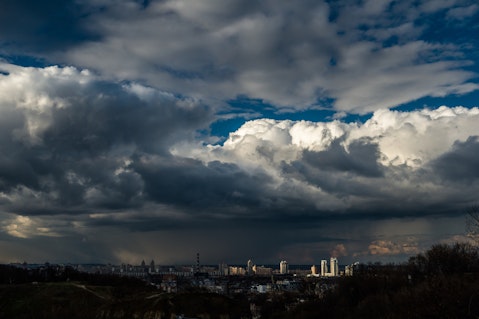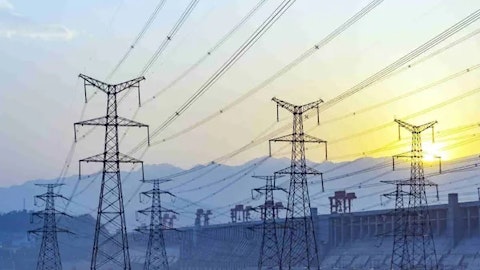In this article, we will take a look at the top 20 rainiest countries in the world. If you would like to skip our discussion on the regional variances in precipitation patterns, you can go to the Top 5 Rainiest Countries in the World.
Precipitation is an important part of the lifecycle on Earth. It supports life in all forms and is crucial for the economic and agricultural development of countries worldwide. Despite the Industrial Revolution of the 18th century, agricultural activity remains an important aspect of economies across the world. Even global powers like the USA, Russia, and China are among the top producers of agricultural products in the world. While China is one of the leading producers of agricultural products, the USA is amongst the largest exporter of the same. In 2023, agricultural exports from the US were valued at $178.7 billion, with a total of 1.89 million farms across the country.
Maintaining an agricultural economy is nearly impossible without ample rainfall. It plays a significant role in economic growth, especially in countries where agriculture is a major sector. For instance, in Thailand, ample rainfall has been identified as a blessing for poor provinces, contributing to their economic growth. In places where farming is the main source of income, like in Africa, unpredictable changes in rainfall patterns can have a major effect on both food availability and economic development. Rainfall can also affect the presence of clean water supply in a country. Sufficient rainfall plays a vital role in sustaining water resources and enhancing sanitation. It aids in refilling groundwater reserves that are necessary for both drinking water and irrigation. This is especially significant in areas where the shortage of water is a major problem.
Global Rainfall Disparities
While the list of the top 20 rainiest countries in the world is dominated by Asian, African, and South American countries, Iceland is amongst the most rainy countries in Europe, with an average annual precipitation of 1288 mm per year in 2022. Other countries that made it to the list of the top 10 wettest countries in Europe are the UK, Norway, Austria, and Ireland. On the other hand, Middle Eastern countries like Egypt, Algeria, UAE, and Oman are amongst the driest countries in the world. Meanwhile, Malaysia is the most rainy country in Asia, with an average annual precipitation of 3485 mm per year. The world’s average rainfall per year stands at about 990 mm. However, this rainfall is unevenly distributed across the planet. This is why some countries, like Malaysia, receive 3.5 times the average global precipitation while others, like China, only receive 0.6 times the global average rainfall.
Leading Players in the Water Utility Industry
Since rainwater is one of the primary sources of freshwater in many regions across the world, it is imperative to use this water supply wisely and store it for efficient consumption. Many companies around the world are actively engaged in conserving water through the development and implementation of rainwater harvesting systems. These companies use innovative technologies and solutions to address water scarcity, promote environmental sustainability, and conserve energy.
One such company is the American Water Works Company Inc. (NYSE:AWK), which is the largest listed water and wastewater utility in the US, serving about 14 million people across 14 states. American Water Works Company Inc. (NYSE:AWK) has a diversified customer base, including residential, public, and commercial customers, and long-term military contracts add stability to its operations. Due to the significant influence of climate change on rainfall patterns globally, American Water Works Company Inc. (NYSE:AWK) advocates for initiatives taken by water utilities to evaluate their energy consumption and carbon footprint. It encourages the reduction of energy usage and greenhouse gas emissions by devising energy efficiency management plans.
Valmont Industries Inc. (NYSE:VMI) is another global leader in the water and wastewater infrastructure industry. The company provides a wide range of services and products to improve water quality and supply. Valmont Industries Inc. (NYSE:VMI) operates in different regions worldwide, serving both residential and commercial markets. The company produces a variety of products, including irrigation equipment, lighting and traffic poles, windmill support structures, and steel utility poles.
Similarly, Xylem Inc. (NYSE:XYL) is a top water technology company with global utility, industrial, commercial, and residential customers. Xylem Inc. (NYSE:XYL) has grown by acquiring other companies, such as Evoqua, a water treatment company that was acquired for $7.5 billion in 2023. As a result, Xylem’s revenue is expected to continue growing. The company has widespread influence around the world, with businesses in over 150 countries.

Anri Gor/Shutterstock.com
Our Methodology
To identify the top 20 rainiest countries in the world, we analyzed the average annual precipitation data for the last two recorded years (2021 & 2022). To exclude anomalies, we calculated the average precipitation levels over these two years and ranked the countries accordingly in ascending order.
By the way, Insider Monkey is an investing website that tracks the movements of corporate insiders and hedge funds. By using a consensus approach, we identify the best stock picks of more than 900 hedge funds investing in US stocks. The top 10 consensus stock picks of hedge funds outperformed the S&P 500 Index by more than 140 percentage points over the last 10 years (see the details here). Whether you are a beginner investor or a professional one looking for the best stocks to buy, you can benefit from the wisdom of hedge funds and corporate insiders.
Top 20 Rainiest Countries in the World
20. Comoros
Precipitation Rate 2022 = 2388 mm
Precipitation Rate 2021 = 1894 mm
Average Precipitation Rate = 2141 mm
Known for its tropical marine climate, Comoros experiences a rainy season from November to May, marked by significant rainfall. This climate plays an important role in the country’s agriculture and biodiversity but also poses challenges such as soil degradation and erosion due to improper terracing and deforestation.
19. Belize
Precipitation Rate 2022 = 2715 mm
Precipitation Rate 2021 = 1939 mm
Average Precipitation Rate = 2327 mm
Belize’s climate is moist tropical, with a distinct wet season from May to October and a dry season from November to April. The country receives a mean monthly rainfall of 150-400 mm in the south during the wet season, while the rest of the country gets less than 100 mm per month. This climate is heavily influenced by the El Niño Southern Oscillation (ENSO) and the Inter-Tropical Convergence Zone (ITCZ), making Belize prone to hurricane impacts.
18. Trinidad and Tobago
Precipitation Rate 2022 =2502 mm
Precipitation Rate 2021 = 2324 mm
Average Precipitation Rate = 2413 mm
Located in the southern Caribbean, Trinidad and Tobago experiences a tropical maritime climate from January to May with relatively low rainfall, followed by a different moist equatorial climate from June to December. This climate results in two distinct seasons: a dry season and a wet or rainy season.
17. St Vincent and the Grenadines
Precipitation Rate 2022 = 2601 mm
Precipitation Rate 2021 = 2251 mm
Average Precipitation Rate = 2426 mm
This small island nation in the Eastern Caribbean has a climate heavily influenced by the Windward Island chain of the Lesser Antilles. The country’s economy is significantly dependent on agriculture and tourism, with bananas being a major agricultural commodity.
16. Panama
Precipitation Rate 2022 = 2351 mm
Precipitation Rate 2021 = 2514 mm
Average Precipitation Rate = 2433 mm
Panama’s climate is tropical and humid, with two distinct seasons: a dry season from January to April and a rainy season from May to December. The country is known for its biodiversity and is home to the Panama Canal.
15. Equatorial Guinea
Precipitation Rate 2022 = 2438 mm
Precipitation Rate 2021 = 2474 mm
Average Precipitation Rate = 2456 mm
Located in West Africa, Equatorial Guinea has a tropical rainforest climate characterized by high temperatures and heavy rainfall throughout the year. The country is a major producer of oil, which has significant environmental implications.
14. Colombia
Precipitation Rate 2022 = 2856 mm
Precipitation Rate 2021 = 2679 mm
Average Precipitation Rate = 2768 mm
Colombia recorded an average of 2768 mm of rainfall over the last two years. The country is known for its coffee production.
13. Vanuatu
Precipitation Rate 2022 = 2832 mm
Precipitation Rate 2021 = 2829 mm
Average Precipitation Rate = 2831 mm
Vanuatu is an island nation in the South Pacific with a tropical climate characterized by high temperatures and heavy rainfall. The country is known for its coral reefs and increased frequency of extreme weather events.
12. Suriname
Precipitation Rate 2022 = 2782 mm
Precipitation Rate 2021 = 2918 mm
Average Precipitation Rate = 2850 mm
Suriname is among the top 15 rainiest countries in the world. The country has a tropical rainforest climate and is a major producer of bauxite and gold.
11. Philippines
Precipitation Rate 2022 = 3069 mm
Precipitation Rate 2021 = 2815 mm
Average Precipitation Rate = 2942 mm
The Philippines has a tropical monsoon climate with two distinct seasons: a dry season from November to April and a wet season from May to October. The country recorded over 3000 mm of rainfall in 2022.
10. Costa Rica
Precipitation Rate 2022 = 2791 mm
Precipitation Rate 2021 = 3108 mm
Average Precipitation Rate = 2950 mm
Costa Rica has a tropical rainforest climate, with high temperatures and heavy rainfall throughout the year. The country is among the top 10 rainiest countries in the world.
9. Marshall Islands
Precipitation Rate 2022 = 3011 mm
Precipitation Rate 2021 = 2974 mm
Average Precipitation Rate = 2993 mm
The Marshall Islands have a tropical climate. The country is known for its coral reefs and is vulnerable to the impact of climate change, including sea-level rise and increased frequency of extreme weather events.
8. Singapore
Precipitation Rate 2022 = 2895 mm
Precipitation Rate 2021 = 3195 mm
Average Precipitation Rate = 3045 mm
Singapore enjoys over 3000 mm/year of rain on average. The country has a tropical rainforest climate and is a major global financial hub.
7. Indonesia
Precipitation Rate 2022 = 3149 mm
Precipitation Rate 2021 = 3074 mm
Average Precipitation Rate = 3112 mm
Nearly 80% of Indonesia’s landmass is covered by warm water reservoirs. Over the last two years, Indonesia received an average of 3112 mm of rainfall. The monsoons in Indonesia continue from December till March.
6. Papua New Guinea
Precipitation Rate 2022 = 3133 mm
Precipitation Rate 2021 = 3195 mm
Average Precipitation Rate = 3164 mm
Papua New Guinea has a tropical rainforest climate and routinely enjoys precipitation greater than 3000 mm per year. The country is a major producer of gold and copper.
Click to continue reading and see the Top 5 Rainiest Countries in the World.
Suggested Articles:
- 30 Least Developed Countries and Their Characteristics
- 14 Best Defensive ETFs To Buy For Plunging Markets
- 10 Best Momentum ETFs To Buy
Disclosure: None. Top 20 Rainiest Countries in the World is published on Insider Monkey.





